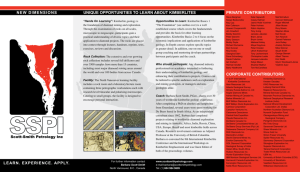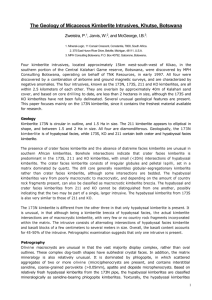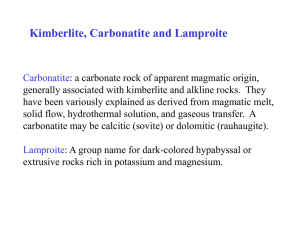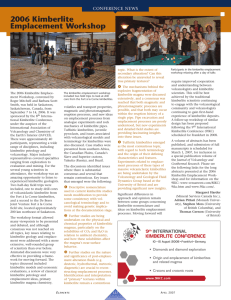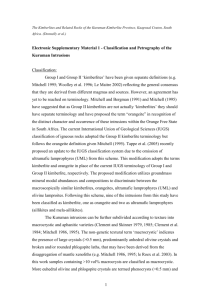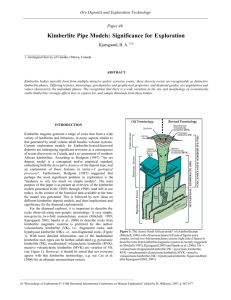pptx file
advertisement
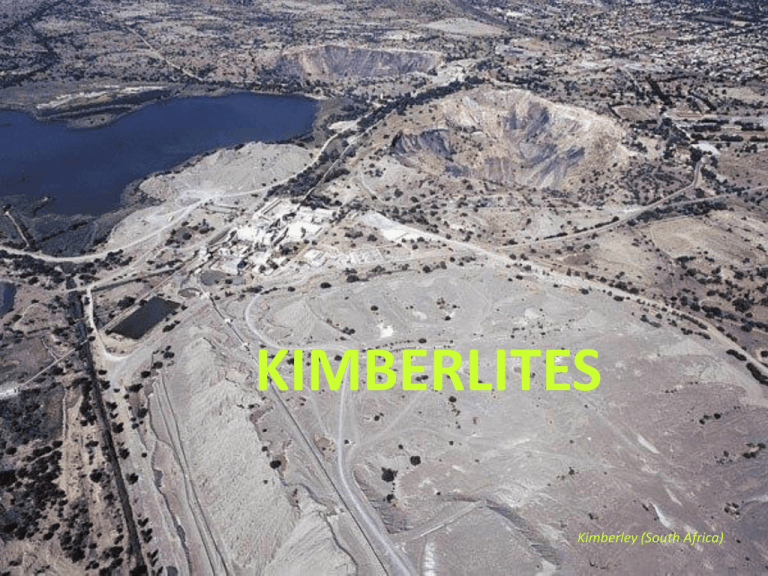
KIMBERLITES Kimberley (South Africa) Lecture contents: 1. 2. 3. 4. 5. 6. 7. 8. 9. What are kimberlites – why are they important Where are they emplaced and when Structural model of a kimberlite: Facies Petrology of kimberlites: - Peridotite solidi - Petrologic classification & relationships with other magmas Geodynamical aspects: - Thermal character of Eons - Tectonic setting of kimberlite-bearing areas Kimberlites as natural mantle samplers Kimberlite prospection Kimberlite mining Market of diamonds References. What are kimberlites – why are they important: 1. Kimberlites are a very rare type of magma with extremely deep origin (>150 km). Their key characters are high K, Mg and fluids (CO2) contents. Some kimberlites originate in diamondiferous part of the Earth’s mantle and carry diamonds to the Earth’s surface, which make these rocks economically important. Despite a large interest, kimberlites are still poorly understood rocks due to their ambiguous composition and difficulties in modeling their source and forming conditions following standard geological methodologies. 1. Kimberlites are the only source of diamonds excepted another unusual alkaline magma suite: Lamproites Lamproites: potassic-rich mafic to ultramafic alkaline rocks characterized by the presence of Ti-bearing minerals like Ti-phlogopite, K-Ti-richterite, wadeite (K, Zr silicate) Chemical and mineralogical composition: - Ultramafic magmatic rocks (SiO2 25-35 wt%, MgO up to 38 wt%) - K2O/Na2O = 2 K2O up to 2 wt% (highly alkaline) - CO2 + H2O 8-15 wt% (high fluid content) - Inequigranular texture - textural components: Macro- & Megacrystals Fine matrix Peridotite and Eclogite xenoliths Diamonds 1. 1. Chemical and mineralogical composition: 1 2 3 Lamp. MORB SiO2 35.2 31.1 33.21 52.7 51.45 TiO2 2.32 2.03 1.97 2.4 2.50 Al2O3 4.4 4.9 4.45 10.8 14.36 Fe2O3 - - 6.78 FeO 9.8 10.5 3.43 5.1 5.50 MgO 27.9 23.9 22.78 8.4 11.06 CaO 7.6 10.6 9.36 6.7 11.49 Na2O 0.32 0.31 0.19 1.3 2.13 K2O 0.98 2.1 0.79 10.4 0.56 CO2 3.3 7.1 4.58 1.0 - H2O 7.4 5.9 8.04 2.6 - tot 100.30 99.24 99.23 100.00* 99.49 1, 2, 3, Lamp.: Mitchell, 1986, lamproite: Leucite Hills, USA MORB: Cmiral et al., 1998 *recalculated to 100% volatile free 1. Crystals: Mg-Olivine * Mg2SiO4 Mg-Ilmenite (Mg,Fe)TiO3 Ti-bearing Pyrope Mg3(Al,Ti,Cr)2[SiO4]3 Diopside CaMgSi2O6 Phlogopite* K2Mg6[Si6Al2O20](OH)4 Enstatite MgSiO3 Cromite (Fe,Mg)(Cr,Al,Fe3+,Ti)2O4 * Often replaced by serpentine and calcite 1. Fine matrix: Olivine Mg2SiO4 Monticellite Ca(Mg,Fe)SiO4 Phlogopite K2Mg6[Si6Al2O20](OH)4 Perovskite (Ca,Na,Fe2+,Ce,Sr)(Ti,Nb)O3 Spinel MgAl2O4 Apatite Ca5(PO4)3(OH,F,Cl) Serpentine Mg3Si2O5(OH)4 Where are kimberlites: 10 1. Navajo-Hopi 2. Brasile 3. West Africa 4. Angola 5. Tanzania 6. Namibia 7. South Africa 8. Yacutia, 9. Australia, 10. NWT - Canada (da A. Gregnanin – personal communication) 2. 2. When were kimberlites formed: Period Age (My) Locality Eocene 50-55 Namibia, Tanzania Upper Cretaceous 65-80 Southern Cape (South Africa) Middle Cretaceous 80-100 Kimberley (South Africa) Lower Cretaceous 115-135 Angola, Siberia Upper Jurassic 145-160 Siberia Devonian 340-360 Colorado, Siberia Ordovician 440-450 Siberia Upper Proterozoic 810 Australia NW Middle Proterozoic 1.100-1.250 Premier (South Africa) Lower Proterozoic 1600 Kuruman (South Africa) October 1869: first diamonds found at Bultfontein and Dorsfontein farms (“Pans”, South Africa) July 1870: more gems found at Koffiefontein and Jagersfontein. Opening of mines and birth of ‘Kimberly’ Structural model of a kimberlite: Facies: Mitchell, 1986 a) Crater facies b) Diatreme or pipe c) Hypabyssal facies 3. 3. Crater facies - Laves (Igwisi Hill, Tanzania) - Pyroclasts (highly erodible; Tanzania, Botswana) -Volcanoclasts (massive process; Tanzania, Botswana) -Sedimentary volcanogenic deposit (terrigenuos fraction + volcanic fraction, inside natural lows; Yakutia, Russia) 3. Diatreme facies DIATREME: conic shapes thinning downwards, composed of angular and rounded clasts (maybe xenoliths) with or without matrix -Variable morphology - Lithics, minerals, matrix - Origin not clear: a) Hydrovolcanism b) Volatile condensation and rapid quenching - pelletal lapilli and autoliths* 3. Hypabyssal facies - Located at diatreme roots: dikes and sills - medium-coarse grain size, homogeneous or with evidences of segregation processes (gas condensation, immiscibility) - presence of globular segregation features (up to 10 cm) giving the aspect of a conglomerate Theoretical sketch of a kimberlite Crater facies Diatreme Hypabyssal facies 3. 3. Realistic sketch of a kimberlite KCF: Crater facies K1, K2: Diatreme facies Petrology of kimberlites: 4. Kimberlitic melt: generated by low degrees of fusion of a phlogopite bearing carbonated-peridotite, at the right T, P and volatile species fugacity (essentially H2O & CO2). Peridotite mineralogy: Olivine (>60%), Clynopyroxene, Orthopyroxene and one aluminum phase (for growing depths plagioclase, spinel or garnet) Peridotite chemistry: MgO (~ 40%), SiO2 (~ 45%), Al2O3, CaO, FeO all of them < 10 wt%, Na2O e K2O almost negligibile. 4. Melting of mantle peridotite: Peridotite ‘solidus’ intersects the ’geotherm’ . 4 main types of solidus : 1) “Anhydrous”: 2) “Water-bearing” (> 0,3-0,5 wt% H2O); 3) “CO2-bearing” (> 5 wt% CO2); 4) “Fluid-absent amphibole-bearing” (water vapour present only during first melting) ~ 45 km Melting of mantle peridotite: 4. Source rock: Dol-Phl-bearing peridotite P > 30 Kbar: alkaline picrites P ~ 55 Kbar: kimberlites (low degrees of melting) What conditions are necessary to yield a kimberlite? 1) Type of ‘solidus’: H2O & CO2 present but in small amounts 2) Phlogopite-bearing peridotite (Potassium enrichment) “METASOMATIC MANTLE” The generation of this type of source-rock is thought to be bond with upwelling of mantleplumes highly enriched in fluids and incompatible elements (e.g. potassium) 4. 4. 3) Low degrees of partial melting at very high P, ≥ 40 kbar (below continental shields); This set of conditions could be realized only below a craton or a ‘mobile belt’ So there are 2 types of kimberlites: - On-craton: located in the middle regions of cratonic areas - Off-craton: placed at the boundaries between cratons, on mobile belt terrains (withouth diamond) ; 4. From these sketches it is evident that the solidus of interest intersects the cratonic geotherm (cold geotherm) where diamond is the stable carbon polymorph, whereas the stable phase would be graphite when below a mobile belt (hot geotherm). [ Kirkley, M., in ‘The Nature of Diamonds’, 1998 ] 4. Classification of kimberlites: Kimberlites might be divided in three different types based on the geodynamic context of their emplacement. Evidence is found in the type/s of xenoliths occurring in kimberlites. K1: no diamond K2: eclogitic diamond K3: peridotite-type macrodiamonds 5. Geodynamical aspects: Thermal character of Eons Eon Age (Gy) Archean 4.5 – 2.7/2.5 Proterozoic 2.7/2.5 – 0.57 (0.54) Phanerozoic 0.57/0.54 – present Archean: microplate tectonic Proterozoic: intraplate tectonic Phanerozoic: plate tectonic 5. Thermal character of Eons Komatiites Diapirism and underplating (ipersolidus) Ductile flow (subsolidus) Brittle regime and oceanization Intermediate depth crust average temperature variation with geologic time (Wynne & Edward, 1976) Achaean heat-flux probably 4-5 times larger than present. Vigorous mantle convection Tectonic setting of kimberlite-bearing areas: 5. The following models have been proposed to describe possible emplacement settings for kimberlite magmas. 1. Lithospheric faults: Lithosphere is crossed by a limited number of deep faults extending towards the upper mantle kimberlites would rise through these fractures, which represents permanent upwelling channels 2. Extension of transform faults: Their localization would be determined by pre-existing continental fractures as leftover of transform faults on continents kimberlites would rise through these fractures; Tectonic setting of kimberlite-bearing areas: 5. 3. Hot-spot magmatism: Hot-spot below continental lithosphere with following thinning and rifting kimberlites are emplaced before rifting; 4. Subduction related magmatism: For mature subduction, melting of oceanic material with production of peridotite and eclogite restites. These leftovers would then melt at larger depths to generate kimberlites evidences of kimberlites located parallel to fold belts. Tectonic setting of kimberlite-bearing areas: 5. 5. Nucleus model: V.M. Moralev e M.Z.Glukhovsky, 2000 This model try to explain the genesis of crustal diamonds, by assuming the existence of hyper-pressure zones in the Archean (diamonds age: 4-2 Ga). Complex model. Kimberlite upwelling spots are located in the central portions of these hyper-pressures areas. Kimberlites as natural mantle samplers: Kimberlite magmas carry xenoliths of peridotite and/or eclogite rocks original of the deepest upper-mantle (maybe even lower-mantle) otherwise not accessible to human investigation. An interesting case study is the reconstruction of the paleo-geotherm of the Slave Craton in Canada. Analyses of eclogite and peridotite xenoliths of the Jericho kimberlite (172 Ma) and high-T-P experiments, aimed to reproduce the phase assemblages of those xenoliths, lead to the reconstruction of the P-T curve below the Slave Craton at the time of Jericho Kimberlite emplacement (Kopylova et al., 1998). The “stratigraphy” of the paleo-mantle of the craton was also prepared. 6. Kimberlites as natural mantle samplers: 6. Moreover diamonds often contain inclusion-minerals which are also a source of precious information to reconstruct the composition and the conditions of the mantle below continents at the time of their emplacement. - Baddleyte inclusions in diamond (ZrO2): Compositional analyses on these inclusions from diamonds of the Mbuji Mayi kimberlite (Congo) indicate provenience from the lower mantle. - Mg-wustite (Mg,Fe)O inclusions: Often found in macro-diamonds, they also require a lower-mantle origin Kimberlites ore prospection: In different stages of the ore prospection (strategic or tactic) the following methodologies are employed: 1) Airborne and land magnetometry: magnetic anomalies due to the presence of ferromagnetic material (ilmenite) are mapped. Those anomalies could be positive (e.g. South Africa), or negative (e.g. Australia). 2) Airborne and land electromagnets: anomalies due to the presence of conductive material at the surface of kimberlite terrains. 3) Airborne and land gravimetry: crater and diatreme shows negative gravitational anomalies; 4) Radiometric and spectrometric methods: negative and/or positive anomalies due to presence of U, Th and K within respect to the background terrain. 7. 7. Kimberlites ore prospection: 5) Remote sensing; 6) Chemical analyses of pathfinder or index minerals: Garnet, Ilmenite, Clinopyroxene, olivine, zircon - Blue and yellow ground: field observation! Ternary diagram where the peculiar composition of ilmenites from diamond bearing kimberlites is highlighted (Finger, 1972) Ni vs Cr plot of fertile-kimberlite-ilmentes: Ni/Cr ratio spans between 2 and 15. Kimberlites ore prospection: INDEX MINERALS: Garnet: Unusually low in Ca, high Mg, Cr; referred to as G10. Ilmenite: Mg-bearing ilmenite. Diopside: Emerald-green, high-Cr-diopside These minerals are usually found in re-deposited volcanoclastic sediments in rivers, downstream within respect of the actual location of the diamondiferous pipe. A case study is the reconstruction of the “migration” path of microdiamonds and index minerals found in glacial (till) sediments in Northwest Territories, leading to the discovery of the Ekati kimberlite. 7. Kimberlites ore prospection: New type of prospection: Analyses of natural and induced resorption or/and etching features on natural diamond crystal to deduce fertility of kimberlite pipes. Operated with SEM and in a close future also with AFM (Atomic Force Microscopy). Prof. Yana Fedortchouck (Dalhousie University) is the world leader for these types of investigation. More info from me and at: http://earthsciences.dal.ca/people/fedortchouk/fedortchouk_y.html 7. 8. Kimberlites ore mining: Several approaches depending on topography and mining stage: - Open pit: up to a certain (safe) depth Yacutian Open Pit, Russia Finsch Diamond Mine, South Africa 8. Kimberlites ore mining: - Sublevel Caving (used in Kimberley) Open pit exhaust Sub-levels net Actual Mining Market of diamonds: Two main uses of diamond crystals: 1) Industry: High quality abrasive, cut-tools, drilling tools, digging (oil perforation), laser optic element, diamond windows, supercomputers, electronic devices, atom smasher (LHC, Geneva), flat panel displays. 2) Jewellery: most priced gem. There exists exceptionally large stones. Gem size is expressed in carats (1 carat = 0.2 grams). The “Cullinan” diamond was a 3’016 carats. From it many gems were cut, among those the Cullinan I, 516 ct. 9. Diamond Anvil Cells: used in experimental petrology Record pressure 4.6 Mbar ! Our lab: HDAC very important !!! 9. The Diamond: Crystallographic and mineralogical characteristics: - Color: All, mainly colorless; - Crystallographic system: Cubic; - Formula: C; - Hardness: 10 (Mohs), 8’000 (Knoop) - Density: 3,52; - Opacity: Transparent; - Fluorescence: yellow, green, pink, often also blue (useful to distinguish from synthetic crystals); 9. More diamonds: 9. Diamonds resources: in millions of carats Country Australia Production (106 ct) 40.8 Zaire Botswana Russia 20.0 16.8 12.5 South Africa South America Angola Namibia 9.1 2.0 1.9 1.3 Ghana 0.8 Canada (expected) World total ca. 3 107.9 9. Data from: Metals & Minerals Annual (1996) More recent data: Canada: Ekati ~ 4 Mct/y Diavik ~ 8 Mct/y Jericho ~ 0.4 Mct/y Total Canada: ~ 12.4 Mct/y Market of diamonds: all values in million carats 800 700 600 500 400 300 200 100 0 -100 698 644 334 297 9. Resources and in Risorse e riserve carati al 311999 Dicembre reserves, 1999 Movements, 2000 nel Movimenti, in carati, 2000 239 Adjustments, in 2000 Aggiustamenti, carati, nel 2000 142 98 -1 -8 -29 -8 -46 Presumed Risorse resources Presunte Indicated Risorse resources indicate Probable Riserve resources probabili Resources and in Risorse e riserve carati al 312000 Dicembre reserves, 2000 Resources: the actual yearly production of ore (diamond, metal, etc.) Reserves: estimated amount of resources in already operating mines Movement: it reflects the removal or exploitation of reserves or resources Adjustment: it reflects increment or decrement of resources or reserves References: Books: Kimberlites, Roger H. Mitchell, Plenum Press, 1986 – 442 p. Petrology of Lamproites, R. H. Mitchell & S.C. Bergmann, Plenum Press, 1991 – 451 p. The Nature of Diamonds, various authors, Cambridge University Press, 1998, 278 p. Articles: Kopylova, M.G., Russell, J.K., Cookenboo, H., Upper-mantle stratigraphy of the Slave Craton, Canada: insights into a new kimberlite province, Geology, vol. 26, 1998, p. 315-318. Mitchell, R.H., Aspects of the petrology of kimberlites and lamproites: some definitions and distinctions, in Proceedings of the Fourth International Kimberlite Conference ,1986, vol.1, p. 7-45. Mitchell, R.H., Kimberliets and Lamproites: Primary Sources of Diamonds, in Ore Deposit Models, 1993, vol. 2, Geoscience Canada Reprint Series 6, p. 13-28. Moralev, M.V., Glukhovsky, M.Z., Diamond-bearing kimberlite fields of the Siberian Craton and the Early Precambrian geodynamics, Ore Geology Reviews, vol. 17, 2000, p. 141-153. Big Hole, Kimberley http://www.zolfo78.com/lectures More info available from me: Office 2056 – Phys. Scie. Bldg. or gsolferi@stfx.ca

